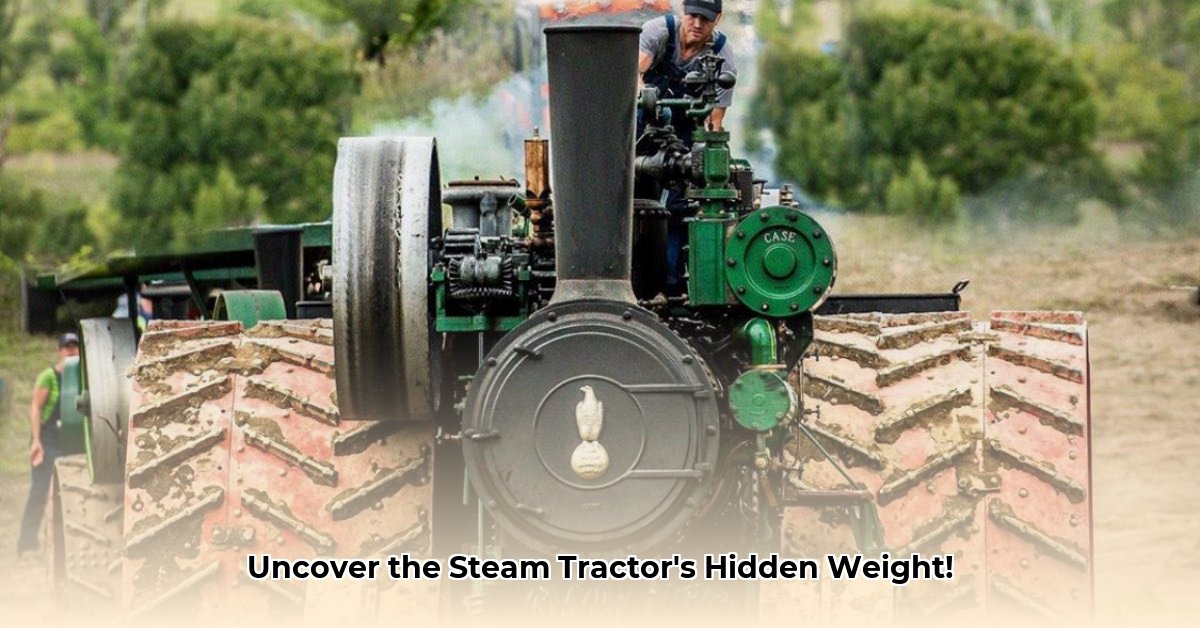
Case 150: A Colossus of the Fields
The Case 150 steam tractor—a titan of early 20th-century agriculture—commands attention not only for its immense power but also for its sheer weight. This seemingly simple characteristic is pivotal to understanding its capabilities, operational challenges, and enduring legacy. This guide delves into the fascinating world of the Case 150's weight, exploring its historical context, technical specifications, and the ongoing efforts to preserve this iconic machine. For more on tractor weights, see this helpful resource: Tractor Weights.
Historical Context: A Giant of its Time
The Case 150, a product of the Case Threshing Machine Company (later J.I. Case), emerged during a transformative era in agriculture. Its robust design reflected the demands of the time—the need for powerful, reliable machinery capable of tackling vast fields. While precise production numbers remain elusive, its rarity today underscores its historical significance. Its weight, approximately 8,000 pounds, wasn't arbitrary; it was a critical design factor integral to its performance and operational characteristics. The sheer mass and power of the Case 150 transformed farming practices, allowing farmers to cultivate larger acreages more efficiently. How did this weight contribute to its success? Let's explore.
Technical Specifications & Weight Breakdown: A Deep Dive
The Case 150's impressive weight stemmed from its robust construction. While precise component weights are scarce, we can estimate based on similar machines and the era's engineering practices. The engine and boiler, the heart of the machine, likely constituted the largest portion of the overall weight (4,000-5,000 lbs). The sturdy chassis and massive wheels, essential for stability and traction, likely added another substantial amount (2,000-2,500 lbs). The remaining weight can be attributed to various accessories, tools, and other crucial components (1,000-1,500 lbs). This results in an estimated total weight of 7,500-9,000 lbs. This weight distribution was carefully engineered for optimal balance and stability, crucial for safe and effective operation, especially on uneven terrain. Could a more efficient weight distribution have been achieved with the technology of the time?
| Component Group | Estimated Weight (lbs) | Notes |
|---|---|---|
| Engine & Boiler | 4000 - 5000 | Heavy-duty components essential for steam generation |
| Chassis & Wheels | 2000 - 2500 | Robust iron construction; crucial for stability and traction |
| Other Components | 1000 - 1500 | Tools, accessories, water tank, etc. |
| Total Estimated Weight | 7500 - 9000 (approx.) | This is a calculated estimate based on similar models. |
Operational Aspects and Maintenance: The Challenges of a Giant
Operating the Case 150 wasn't a simple task. Its massive weight presented significant logistical and operational challenges. Maneuvering this behemoth required considerable skill and manpower. Fueling—often requiring coal or wood—was a constant and demanding process. Boiler maintenance, a crucial aspect of operation, demanded specialized knowledge and meticulous care. The high-pressure steam system required expert handling, and any malfunction could have serious consequences. What were some of the most common maintenance issues faced by Case 150 operators?
Restoration and Preservation: Keeping History Alive
Preserving these magnificent machines is a labor of love, often requiring extensive research, sourcing rare parts, and years of dedicated effort. Many enthusiasts and collectors dedicate their time and resources to restoring Case 150 tractors, ensuring that a piece of agricultural history remains intact. The task of sourcing original parts is exceptionally challenging due to their rarity, often necessitating the painstaking reproduction of components and requiring deep mechanical expertise. What are some of the most common challenges faced during the restoration process?
Conclusion: A Legacy of Strength and Endurance
The Case 150 steam tractor represents more than just a machine; it embodies an era of agricultural innovation and the ingenuity of its creators. Its impressive weight, far from a mere statistic, embodies its power, durability, and lasting impact. While operating and maintaining such a behemoth presented unique challenges, the ongoing efforts to restore and preserve these machines stand as a testament to their enduring appeal and the dedication of enthusiasts who strive to keep agricultural history alive. The legacy of the Case 150 continues to inspire and educate, reminding us of the remarkable engineering advancements that laid the groundwork for modern agriculture.